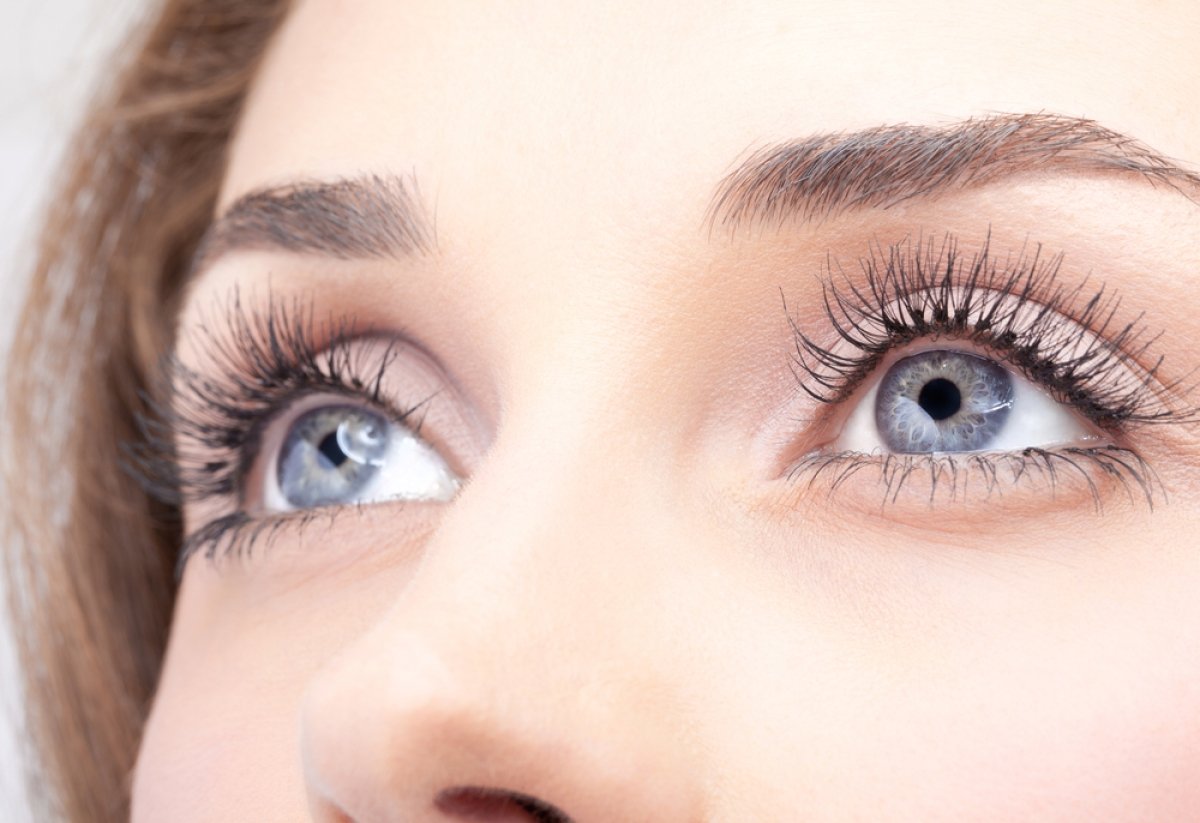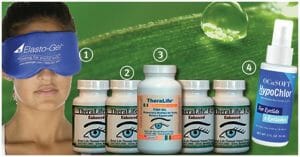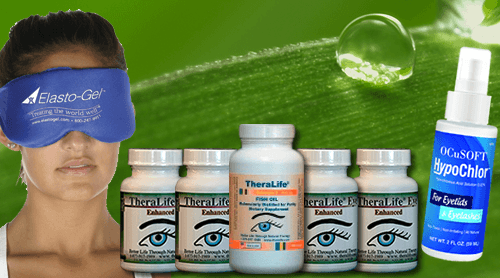Your swollen eyelid might be a chalazion, which is often due to a blocked oil gland. Unlike a stye, a {Plural of chalazion is chalazia- it is typically a firm, painless lump that develops slowly and may last for months.
TheraLife’s products offer effective management solutions for chalazia and other related conditions. The use of TheraLife’s natural supplements can help reduce inflammation and support overall eye health, potentially alleviating symptoms like mild tenderness and redness. For more persistent cases, TheraLife provides guidance on additional treatments, including warm compresses and gentle massages, which can complement their products. Understanding the distinct signs of a chalazion and utilizing TheraLife’s comprehensive approach can aid in better managing this condition.
Get Rid Of Chalazia- Stop Recurrence
Add To Cart
Key Takeaways
- Chalazion results from a blocked oil gland, forming a small, firm, painless lump on the eyelid.
- Initial symptoms include redness and mild tenderness, which usually decrease over time.
- Chalazion differs from styes, which are painful and result from eyelash follicle infections.
- Diagnosis requires careful examination to distinguish from infections and other serious conditions.
- Treatment includes warm compresses, eyelid hygiene, and potentially corticosteroid injections for inflammation.
Causes of Eyelid Swelling
When your eyelid swells, it can often be attributed to several common causes rooted in underlying medical conditions. Understanding eyelid anatomy is essential, as the swelling mechanisms often involve blocked oil glands, leading to conditions like chalazia. Bacterial infections, such as styes, also contribute to swelling by inflaming the eyelid’s sebaceous glands. Allergic reactions, both local and systemic, can elicit swelling through histamine-mediated pathways. Prompt identification and treatment of these causes are crucial, as eyelid swelling may sometimes indicate more serious conditions. Chronic inflammation, as seen in blepharitis, disrupts normal eyelid function. It is important to distinguish between different conditions, such as chalazia and hordeola, to guide appropriate treatment. Thyroid dysfunctions, particularly hyperthyroidism, alter the eye’s appearance, although they more commonly cause bulging. Less frequent causes include infections like orbital cellulitis, which involves deeper ocular tissues, or systemic conditions like nephrotic syndrome, affecting fluid balance and contributing to eyelid edema.
Recognizing Chalazia Symptoms
To identify a chalazion, observe for a small, firm lump on the eyelid that may initially present with redness and tenderness but becomes painless over time. Unlike a stye, a chalazion often causes minimal redness and discomfort, though it can lead to blurred vision if large enough to exert pressure on the eye. Warm compresses are a recommended treatment for chalazia as they help facilitate drainage of gland contents and reduce inflammation. It’s crucial to distinguish these symptoms from other conditions, such as infections or eyelid cancers, for accurate diagnosis and management. Chalazia result from the blockage of meibomian glands, leading to inflammation and granuloma formation.
Common Chalazia Indicators
Understanding common chalazion indicators is important for recognizing its symptoms early. You may notice a small bump or lump on your eyelid, often accompanied by swelling that varies from mild to severe. Redness and tenderness around the lump are common, usually developing gradually over several days. Practicing good eyelid hygiene is essential for chalazion treatment and prevention. The chalazia often appears on the upper eyelid, presenting as a firm, solid nodule that’s typically painless unless infected. A chalazion forms when a meibomian gland becomes blocked, leading to the development of a lump on the eyelid. Visual effects may include blurred vision if the size compresses the eyeball, alongside mild irritation and increased tear production. Eyelid care is essential as chalazions can coexist with conditions like blepharitis. For effective chalazion treatment, early detection and management are critical, particularly if you experience symptoms such as temporary discomfort or sensitivity when blinking.
Differentiating Chalazia Symptoms
Recognizing chalazion symptoms is essential for effective management and treatment. Chalazia typically arise due to chalazion causes like blocked oil glands in the eyelid. Poor eyelid hygiene can contribute significantly to the blockage of these glands. They’re commonly located on the upper eyelid but can appear on both. Sizes vary from 2-8 mm, potentially affecting multiple eyelids simultaneously. Unlike styes, chalazions are less painful and less red, primarily presenting as a small, firm lump that may cause mild irritation and increased tearing. Redness and swelling can occur, but severe vision issues are rare unless the chalazion is large. Untreated chalazia can lead to complications like preseptal cellulitis, emphasizing the importance of addressing them promptly. For accurate diagnosis, a healthcare provider will examine the eyelid’s physical characteristics and assess any underlying conditions. Proper identification informs appropriate chalazion treatment, distinguishing it from other eyelid disorders.
Examining Swollen Eyelid Appearance
When examining a swollen eyelid, you should differentiate between a chalazion and a stye based on their clinical presentation. A chalazion typically forms a non-tender, pea-sized lump under the eyelid, whereas a stye presents as a painful, red bump near the eyelid edge. It’s important to note that a chalazion often results from blockage of the meibomian gland, leading to inflammation but generally not infection. Preventative measures such as keeping eyelids clean and applying warm compresses can help manage and prevent chalazia. Identifying these distinct swelling characteristics is essential for accurate diagnosis and effective management.
Chalazion vs. Stye
Ever wondered how to tell the difference between a chalazion and a stye when your eyelid’s swollen? Understanding chalazion causes and the stye comparison is essential.
A chalazion results from a blocked oil gland, often forming a firm, painless bump on the upper eyelid with a slow onset. It mightn’t be noticeable initially but can lead to blurry vision if large enough. Interestingly, chalazia are more common in individuals with conditions like acne rosacea, which increases the risk of blocked oil glands. Chalazia are often associated with posterior blepharitis, a condition where oil-secreting glands are affected, leading to dry eyes.
Conversely, a stye is a rapid-onset, painful infection of the eyelash follicle, presenting as a pimple-like bump with scratchy sensations and crustiness.
Differentiating these conditions relies on recognizing their distinct symptoms and onset patterns. Accurate diagnosis guarantees appropriate treatment, such as warm compresses and, if needed, antibiotics or surgical intervention.
Identifying Swelling Symptoms
Curious about what symptoms might accompany a swollen eyelid? You may notice redness, inflammation, and a scratchy sensation, often linked to allergy reactions or infection causes. Photophobia, or light sensitivity, can occur alongside excess tear production, leading to watering eyes. The swelling might obstruct vision, and you could observe dryness or flaking. Swollen eyelids can sometimes signal underlying health issues that necessitate medical attention. When infections like blepharitis or conjunctivitis are involved, eye discharge and eyelid soreness are common. Allergens such as pollen, dust, or animal dander also contribute to these symptoms. The body-focused repetitive behaviors associated with Mucus Fishing Syndrome can exacerbate eye irritation, potentially leading to swelling. In some cases, the white part of the eye appears red. Serious conditions, like orbital cellulitis, require prompt medical attention. Understanding these symptoms helps distinguish between various causes, facilitating effective treatment and preventing further complications.
Diagnosing Chalazia
How can you accurately diagnose a chalazion? Start with a meticulous eyelid examination. Clinically, a chalazion diagnosis relies on identifying a painless, firm lump, often on the upper eyelid, caused by a blocked meibomian gland. During assessment, consider these key factors:
- Location and Size: Observe the lump’s precise position and dimensions on the eyelid.
- Symptoms: Evaluate for swelling, redness, and any mild tenderness.
- Differential Diagnosis: Distinguish from other conditions such as styes or eyelid malignancies.
- Complications: Look out for signs of secondary infection or vision issues.
Regular assessment of chalazia size, color changes, and associated discomfort is crucial for evaluating treatment effectiveness. Eyelids play a crucial role in eye health by protecting the eyes and distributing tears. Typically, chalazia are diagnosed without special tests, but in atypical cases, further investigations like biopsy or imaging might be necessary.
Early, accurate diagnosis is essential to prevent complications.
Effective Chalazion Treatments
When managing a chalazion, understanding effective treatment options is essential for resolution and comfort.
Begin with natural remedies like applying warm compresses for 10-15 minutes, four to six times daily, which promotes glandular drainage. Complement this with gentle eyelid massage to facilitate fluid movement. Aloe vera and cucumber slices can reduce swelling, while diluted tea tree oil may offer additional relief. Chalazia usually resolve within a month with consistent home treatment. Incorporating lid hygiene practices such as warm saline soaks can enhance treatment outcomes by improving circulation and promoting healing.
Maintain proper eyelid hygiene to prevent further blockage.
If these natural remedies are ineffective, consider medical interventions. Corticosteroid injections can reduce inflammation, while surgical drainage under local anesthesia may be necessary for persistent or large chalazia.
Blephex treatment helps clear clogged glands, and antibiotic drops address any associated infection. Always consult an ophthalmologist for professional guidance if symptoms persist.
Differentiating Chalazion From Stye
Ever wondered how to differentiate between a chalazion and a stye?
It’s crucial to recognize the stye differences to initiate appropriate chalazion treatments. A chalazion results from a blocked meibomian gland, presenting as a painless, firm bump deep in the eyelid. Both conditions benefit from warm compresses, which can help reduce swelling and promote healing. Chalazia are often linked to chronic inflammation, which can lead to persistent nodules and require careful management.
Conversely, a stye is a bacterial infection causing a painful, red lump at the eyelid’s edge, often at an eyelash base.
Clinically, key differences include:
- Pain: Chalazia are usually painless; styes are painful.
- Location: Chalazia develop internally; styes appear externally.
- Duration: Chalazia can persist for months; styes resolve within a week.
- Appearance: Chalazia are firm and large; styes may fill with pus and rupture.
Accurate diagnosis guarantees effective management and minimizes complications.
Managing Chalazia Risks
Although chalazia are often benign, managing their risks is essential to prevent complications. Implement preventive measures to mitigate these risks by maintaining strict hygiene practices.
Keeping your hands and eyelids clean is vital; unclean hands can introduce bacteria, exacerbating inflammation. Replace eye makeup regularly to avoid bacterial buildup. Proper contact lens care is also crucial, as lenses can harbor pathogens if not cleaned thoroughly.
Avoid touching your eyes unnecessarily and never attempt to squeeze or drain a chalazion, as this increases infection risk. Managing chronic conditions like blepharitis and rosacea can greatly reduce the likelihood of developing chalazia.
These steps, combined with routine eye care, are evidence-based strategies to manage chalazion risks effectively and maintain ocular health.
Preventing Future Chalazia
Having discussed managing chalazia risks, it’s important to focus on preventing future occurrences. Effective chalazion prevention hinges on meticulous eyelid hygiene and lifestyle adjustments.
Start by incorporating regular hand washing and maintaining eye hygiene to mitigate bacterial transfer and gland blockage.
- Hand Hygiene: Wash hands thoroughly before touching your eyes or handling contact lenses.
- Eyelid Care: Cleanse your eyelids daily, especially if you’ve had previous chalazia or blepharitis.
- Makeup Management: Remove eye makeup nightly and replace it every three months to reduce bacterial buildup.
- Contact Lens Protocol: Disinfect lenses and cases regularly, handling them only with clean hands.
Adopting these practices can greatly reduce the likelihood of chalazion recurrence, promoting ideal ocular health.
Get Rid Of Chalazia- Stop Recurrence
Add To Cart
Frequently Asked Questions
Can a Chalazion Cause Permanent Damage to My Eye?
A chalazion typically doesn’t cause permanent eye damage if identified and treated properly.
Its symptoms include a lump on the eyelid, sometimes leading to blurry vision.
Treatment options focus on reducing swelling with warm compresses or medical intervention if it persists.
Rare complications like orbital cellulitis require urgent care to prevent lasting damage.
By addressing symptoms early, you can effectively manage and prevent potential long-term effects.
Always consult a specialist for persistent issues.
How Long Does It Take for a Chalazion to Heal?
Time heals all wounds, and a chalazion is no exception. Typically, chalazion symptoms resolve within weeks to months.
Smaller ones might vanish quicker, often in a week or two. Larger ones linger longer.
Treatment options like warm compresses can expedite healing by promoting drainage. Medical interventions, such as eye drops or surgical drainage, might be necessary for persistent cases.
Regardless, maintaining eyelid hygiene is pivotal in preventing recurrences.
Are There Any Natural Remedies for Treating Chalazia?
You can explore home remedies and herbal treatments for a chalazion with clinical precision.
Start with warm compresses, a cornerstone in chalazia care, applying them 4-6 times daily. Incorporate tea bags and aloe vera for their anti-inflammatory effects.
Maintain eyelid hygiene with Avenova to prevent further blockages. Avoid squeezing the chalazion and consider using tea tree cleansers or castor oil to promote drainage and reduce swelling.
Can Wearing Contact Lenses Lead to a Chalazion?
Contrary to popular belief, wearing contact lenses isn’t the villain that causes chalazia.
In fact, poor contact lens hygiene and eye irritation might make you suspect otherwise, but evidence shows no direct link.
It’s all about those pesky blocked meibomian glands playing tricks on your eyelid.
Maintain impeccable lens hygiene to avoid infections masquerading as chalazion triggers.
Ironically, your lenses are innocent—until proven guilty of discomfort by an oversized chalazion.
Are Chalazia Contagious to Others?
You might wonder if a chalazion is contagious, but rest assured, it’s not.
Chalazia are caused by blocked oil glands, not infections. Hence, they don’t spread to others.
Symptoms include a painless eyelid lump, which can become red and swollen.
For treatment, apply warm compresses and maintain good eyelid hygiene. This helps alleviate symptoms and encourages healing.
If persistent, consult a healthcare provider for potential intervention.
Get Rid Of Chalazia- Stop Recurrence
Add To Cart
Conclusion
When faced with a swollen eyelid, determining whether it’s a chalazion or another condition is crucial for effective treatment. Theralife.com offers valuable insights and products that benefit customers dealing with such eye issues. Their comprehensive guides help distinguish between a chalazion and a stye, ensuring that individuals can take appropriate care. Beyond treatment, Theralife emphasizes the importance of prevention to avoid future occurrences. Their products are designed with customer well-being in mind, offering natural and effective solutions to a range of eye conditions, including blepharitis, dry eyes, and uveitis. By exploring Theralife’s offerings, you can take proactive steps in managing your eye health and preventing conditions like chalazions from recurring.




